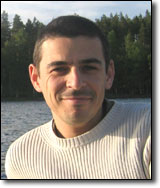
2005 IEEE International Conference on Acoustics, Speech, and Signal Processing
March 18-23, 2005 • Pennsylvania Convention Center/Marriott Hotel • Philadelphia, PA, USA
ICASSP
30th Anniversary
Tutorial TUT-1: Signal Processing in Computational Genomics
Instructors
Ilya Shmulevich; The University of Texas M. D. Anderson Cancer Center
Time & Location
Friday, March 18, 14:00 - 17:00, Location: CC: Room 109
Abstract
There are 20,000 to 25,000 genes in the human genome. High-throughput genomic technologies are now allowing scientists to accumulate a wealth of genetic data and are paving the way to a deeper understanding of biological systems and the disruption of their normal functioning in diseases.
In order to achieve this goal, biologists, engineers, statisticians, and computer scientists are joining forces to work with the enormous amounts of quantitative data being amassed and to render complex problems in mathematical terms. This phenomenon is perhaps best exemplified by the incitation of interdisciplinary scientific activity by the advent of high throughput cDNA microarray technology, which facilitates large-scale surveys of gene expression.
Current challenges in genomics have much in common with those in signal processing, in part because the latter has the advantage of being at the crossroads of many disciplines. The goal of the this tutorial is to introduce to the signal processing community a broad range of topics in modern genomics research, with an emphasis on signal processing models, algorithms, and analytical tools, specifically tailored to the biological problems in genomics.
Outline:
- Introduction to Molecular Biology
- DNA, RNA, protein
- Genes and genomes; gene expression
- The cell
- Genetic organization and control
- Cell communication; signal transduction
- Genetic regulatory networks
- The role of genomics in cancer research
- Microarray technology for large-scale gene expression monitoring
- Overview of several technologies
- The process of making a microarray
- Scanning and image processing
- Quality Control
- Data analysis, processing, visualization, data reduction
- Types of data; gene profiles
- Normalization
- Measures of similarity
- Principal Components Analysis
- Multidimensional Scaling
- Computational and formal methods, models, algorithms
- Unsupervised classification and learning; clustering
- Supervised classification and learning
- Modeling of genetic regulatory networks
- Probabilistic rule-based model classes
- Biological interpretation
- Cellular states and types
- Disease progression
- Dynamic behavior and adaptation
- Relationships to nonlinear digital filtering and estimation
- Data requirements
- Complexity of inference algorithms
- Estimation accuracy
- Simulation
- Markovian analysis
- Convergence
- Steady-state behavior
- Prediction
- Influence of genes on other genes
- Intervention
- Current challenges and goals
Target Audience: This tutorial requires a basic understanding of signal processing and statistical theory and methods (senior undergraduate or graduate level).
Presenter Information

Ilya Shmulevich received his Ph.D. degree in Electrical and Computer Engineering from Purdue University, West Lafayette, IN, USA, in 1997. In 1997-1998, he was a postdoctoral researcher at the Nijmegen Institute for Cognition and Information at the University of Nijmegen and National Research Institute for Mathematics and Computer Science at the University of Amsterdam in The Netherlands, where he studied computational models of music perception and recognition. In 1998-2000, he worked as a senior researcher at the Tampere International Center for Signal Processing at the Signal Processing Laboratory in Tampere University of Technology, Tampere, Finland. Presently, he is an Assistant Professor at the Cancer Genomics Laboratory at The University of Texas M. D. Anderson Cancer Center and an Adjunct Professor in the Department of Statistics in Rice University. He is an Associate Editor of Environmental Health Perspectives: Toxicogenomics and a Senior Member of the IEEE. His research interests include systems biology, genomics, nonlinear signal and image processing, computational learning theory, and music recognition and perception.